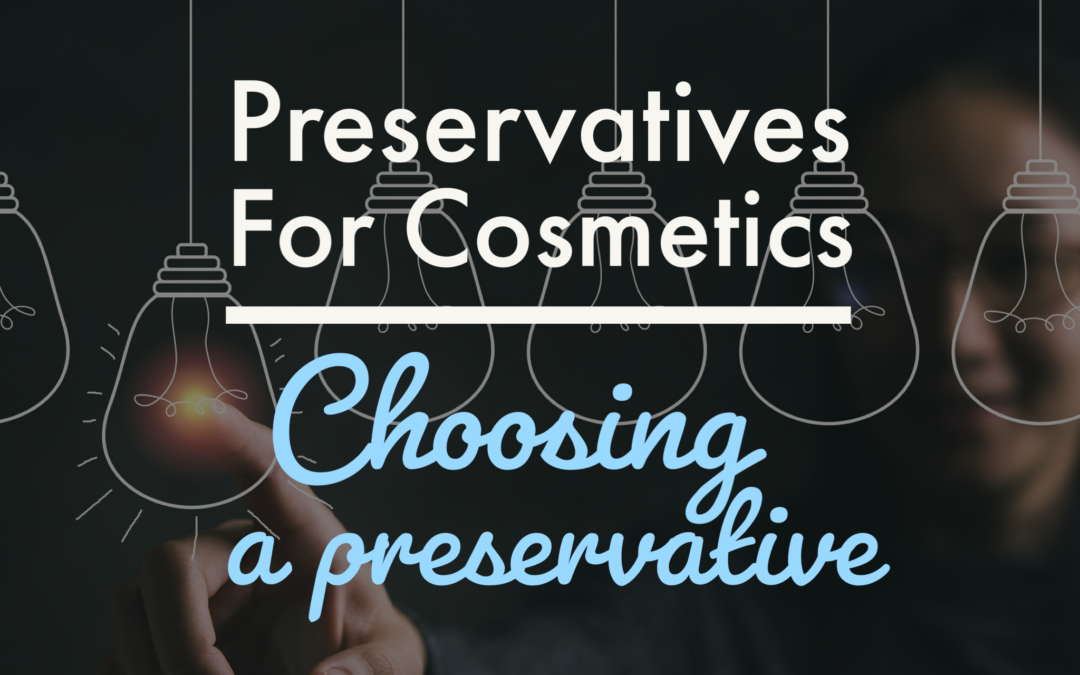In our last blog post we discussed how to know if your product needs a preservative. In essence, if your handmade cosmetic contains water, or will come into contact with water and isn’t a single use item, it will need a preservative!
So now that you’ve determined whether or not your product will need a preservative, the next question is, which one should you use? If you go to any of your favorite handmade cosmetic suppliers and search for preservatives, a dizzying array of options with long chemically sounding names will pop up. How can you possibly choose one?

There are 3 main things you should pay attention to when choosing a preservative.
- Solubility
- Effective pH range
- Temperature it can be added
- Is it broad spectrum

Solubility
When considering solubility, we need to know if the preservative is oil soluble or water soluble. If you’re just starting out, I would suggest using water soluble preservatives as long as the product contains some type of water phase, water-based ingredients, or water soluble ingredients–for example hydrosols, extracts, glycerin, or water-based surfactants. I would suggest using oil soluble preservatives when the product contains mostly, or all, oil-based ingredients. Technically you can use oil soluble preservatives in water-based formulations, and vice versa, but keeping your formula stable can be more complicated! So for now let’s just keep it simple and say that the main ingredients in a product will guide the preservative you should choose.

Effective pH range
Once you have narrowed down your preservative selection based on its solubility, the next thing to look at is what is the effective pH range for that preservative, and what is the pH of your final product.
Most DIY skincare will have a pH of 4-8, but to be certain, you would need to test the pH of your product. This might require you to create a small sample batch and test it. Once you know the pH of your product, you can start matching it up with suitable preservatives. You’ll want to do your best to have your product’s pH fall in the middle of your chosen preservatives range to ensure it will be as effective as possible. The range doesn’t mark a clear cutoff–the preservative won’t instantly stop working at pH 4, instead it will have a gradual decline of effectiveness until it hits pH 4, at which point it is no longer effective at all.
You’ll also want to run stability tests and recheck the pH of your product over time after you have added your preservative. This is because some preservatives can cause the pH to drift. Sometimes you can use this to your advantage, and sometimes it will be at odds with what you’re trying to achieve. Not all preservatives do this, and there are generally good notes in the product description to make you aware of this possibility, but it is something you should be paying attention to.

Temperature it can be added
The next major component of choosing a preservative is taking note of what temperatures it can handle. This will mainly come into play when you are trying to add preservatives to very hot formulations.
If the product needs to be poured into molds at a liquid stage–conditioner bars, solid scrub bars, and our bath crayon recipes come to mind here–then it will need a preservative that can handle high temperatures to ensure that the product doesn’t become too cool and solidify before it can be poured.
If the product has a cool down phase–traditional lotions and sugar scrubs for example–then you might be able to use a preservative with lower heat tolerances. It is important that you use an infrared thermometer to check the temperature of your product before adding the preservative.

Broad Spectrum
Now that we have a baseline of some of the important things we need to consider when choosing a preservative, it’s time to consider the broader picture here–and that’s the issue of broad spectrum!
For the most part, I would generally advise you to choose a preservative that is labeled as broad-spectrum–meaning that it will target bacteria, yeast and mold. You should always read the supplier’s description, and if possible, cross reference that with the actual manufacturer’s description if you’re able to find it.
Painstakingly going through and looking at every preservative you can find on the market may seem exhausting but it’s actually super important. In part, this is how you will learn about preservatives for yourself. And you don’t have to go it alone. We are currently in the process of compiling an extensive database of preservatives with as much pertinent information as we can find on each one by sourcing their supplier statements–not what another blog says about them!

There is a ton of information online and when in doubt, you could always check out the list of preservatives offered by your favorite supplier to help you narrow down the right ones for you. Once you find one or two that you like, it’s pretty likely that those will be primary your go-to preservatives that you use over and over.
My two favorite preservatives are Liquid Germall Plus, which I prefer for water based formulas, and Euxyl PE 9010, which I prefer for oil based preservatives.I also really like CAP 2 preservative as it’s oil soluble and water dispersible. I would highly recommend any of those for someone who is looking to start using preservatives.
If you are still feeling a little lost, then have no fear! Our next blog post will use some examples and break down the actual process I would go through if I was trying to find a preservative! Hopefully though, you’re beginning to get a better idea of how to get started. Being confident about your choices is going to help you feel more empowered as a maker, and of course we love to see that! In the meantime, Happy Making!


